Does Crime Always Deserve Punishment?
WORKSHOP 3: HOW EFFECTIVE IS CRIME DETECTION AND THE JUSTICE SYSTEM?






Inspire Critical Thinking 2023/24
Contents
WORKSHOP THREE:
How Effective is Crime Detection and the Justice System?
WELCOME TO INSPIRE CRITICAL THINKING?
06 Chemical Approaches to Crime
Eleanor Hetherton (Chemistry) – and Summary Video
09 Catching Criminals Red Handed: Vein Identification
Sue Black (Forensic Science)
12 Why was London’s most notorious serial killer never caught?
Katie Inwood (History)
16 Critical Thinking Video: Ima Lyer
Alfie Dry
17 Critical Thinking Skills (Argument Fallacies pt.2)
Lily Middleton-Mansell
22 Engineering Surveillance
Mahira Muhsanat (Engineering) – and Summary Video
26 The Dreyfus Affair
Liz Tiskina (History and French) – and Summary Video
30 Cost of Crime
Hazal Bulut (Politics, Philosophy and Economics) – and Summary Video
34 DNA Fingerprints
Sue Black (Forensic Science)
37 Trial by Social Media (EXTENSION ARTICLE)
Lily Middleton Mansell (Politics) – and Discussion Video (Alfie Dry and Azeez Shekoni)
41 University Spotlight: Oxford Ghost Stories
Lily Middleton-Mansell
44 University Spotlight: Student Union
Lily Middleton-Mansell
45 University Spotlight: Free time in Oxford Video
Rachel Pindar and Ambrose Hlustik-Smith
46 Workshop 2 Super Challenge Winners
48 Coming up
inspire@sjc.ox.ac.uk sjcinspire.com
WELCOME TO INSPIRE CRITICAL THINKING 2024






Dr Tom Kemp: editor, Emeritus Fellow in Biology, St John’s College; Lily Middleton Mansell: student editor, English graduate, St John’s College
This is the fifth year St John’s College has produced its Critical Thinking online programme, and we have grown very proud of it and the 1500 or more annual participants! It is aimed primarily at Years 9 to 11 and is designed for students of all abilities and interests. We are glad to say there is no charge for full participation, neither online nor for coming to our associated Oxford Summer School at St John’s College. Each programme centres around a broad area of human interest, with contributions from many of our colleagues, who are leading, and often internationally renowned academics, and who bring to the topic a wealth of different scholarly viewpoints from the arts, the humanities and the sciences alike. We all share a passionate commitment to education at every level, encouraging students to broaden their understanding of the world and develop their critical thinking skills. We are bombarded nowadays with information from so many sources, some truthful and reliable, others sadly unreliable and maliciously prejudiced. If your generation is going to try and make the world a better place, then it is essential that you learn
how to critically assess rather than unthinkingly accept what you hear and read.
The broad area we have chosen for this year is “Crime and Punishment”. Few aspects of human behaviour have been so pervasive throughout society. Ideas of what even is criminal have changed throughout the course of history and amongst different communities. Philosophers have agonised over what are appropriate punishments, and social scientists over the causes of crime. Several branches of science look at improving ways of apprehending criminals, and medicine is interested in discovering treatments for a tendency towards violence and aggression. Think how much crime enters literature, from the great classics to all those detective novels, into film and drama. How many wonderful medieval and renaissance paintings depict cruel punishments?
DOES CRIME ALWAYS DESERVE PUNISHMENT?
The programme is divided into four successive workshops:
What is a crime?
Are some crimes excusable?
How effective is crime detection and the justice system?
What is punishment and how has it changed through history?
2
Crime and Punishment 3
HOW DO I USE THE WORKSHOPS?

Submit your super challenge piece by the 25th March 2024 for a chance to win.
Throughout this workshop you will find several interactive tasks:
Think pieces
Have your say
Vote now
Super challenges
These are all optional and give you the ability to choose how much you’d like to be involved. There are also resources to help you independently explore the topic in more detail.
The 4 super challenges require a little more thinking but offer you the opportunity to complete a task and a chance to win a prize! You may submit a response to one super challenge per workshop. This can be in any format you wish. Submit your super challenge response to inspire@sjc.ox.ac.uk for the chance to win up to £20 Amazon voucher. With your submission please let us know:
■ Your name
■ Your School
■ Your year group
■ Whether you are happy for us to share your work on social media.
HOW EFFECTIVE IS CRIME DETECTION AND THE JUSTICE SYSTEM?
Welcome to Workshop 3. The all important link between crime being committed and punishment being administered is discovering and arresting criminals and accumulating evidence of their guilt that will stand up in a court of law. The methods of catching criminals during the 19th century had scarcely changed since Medieval times. The immediate circumstances of the crime were noted, eye witnesses sought, and suspects interrogated, often quite brutally, to elicit damning statements even to the point of an admission of guilt. Such investigations were riddled with conscious and unconscious prejudices, and undoubtedly many miscarriages of justice resulted.
The most famous 19th century fictional detective of this time was Sherlock Holmes. The author, Arthur Conan Doyle, endowed Holmes with an extraordinary ability to observe small signs or clues unnoticed by anyone else, plus a deep knowledge of such things as different kinds of tobacco or sole patterns of shoes, to make logical inferences about the crime. This was all very fanciful at the time, but it anticipated the 20th century rise of forensic science and the development of completely new kinds of evidence. Scotland Yard started to use fingerprints as evidence in 1901. The French scientist Edmund Locart, who expressed the principle underlying modern forensic science that “Every contact leaves a trace”, set up the world’s first forensic laboratory in 1910, complete with a range of microscopic and chemical analytical equipment.

Today society spends a huge amount of money continuing to develop effective new methods of crime detection. Nothing illustrates Locart’s principle more than the sensitivity of DNA analysis, while the rise of computerised data bases and photographic imaging has revolutionised police enquiries.
But as you think about this, you must always bear in mind that every technique for crime detection has a potential for error and bias. Can we be sure where a DNA sample on a victim’s clothing actually came from? Can we be sure an incriminating digital image has not been created in photoshop?
Our third piece about critical thinking is a continuation of the last, with a description of some more of the fallacies commonly used to try and persuade us to accept a particular argument or point of view. I hope by the time you have studied this you will be more adept at carefully evaluating sources of information and commentary. When you have finished, do try the super challenges to test yourself!
Dr Tom Kemp, editor
Lily Middleton-Mansell, student editor
INTRODUCTION
TO WORKSHOP 3
4 5
X

Identifying and Detecting Drugs – How Chemical Equipment can Help in the Court of Law
CHEMISTRY
Author: Eleanor Hetherton, 4th Year Chemistry student, St John’s College
Testing for drugs is hugely important in society today. In 2022/23, there were approximately 177,994 drug offences across England and Wales and in 2021 the number of drug-driving cases reached 21,411. Should these cases be taken to court, concrete evidence is needed to convict those arrested. How do the police know that the substance they seized is an illegal drug? Or how do they know if a person has been taking drugs and getting behind the wheel? They need to test for them - this is where chemistry comes in.
Let’s focus on the first scenario, where we have a substance but don’t know what it is, and we need to find out if it is an illegal drug. First off, it will be sent to a lab where it can be tested. Street drugs rarely come in their pure form, they are often mixed with substances called diluents, to bulk the mixture out. Examples of these diluents are sugars, talcum powder, magnesium sulphate or inositol, which is converted to glucose when metabolised by the body. Therefore, there needs to be a way to separate these components of a drug mixture, so that the active drug can be correctly identified. This separation process is carried out
using a chemical technique called gas chromatography.
Watch a summary of how gas chromatography works here.

Gas chromatography is a way to separate out compounds that have different boiling points, the sample to be tested is mixed with a solvent to liquidize it and this liquid is then vaporised into a gas.
This gas is then joined up with a stream of unreactive carrier gas, such as helium or nitrogen, which makes up the mobile phase. The mobile phase is passed through a glass column with a liquid coating
on the side, the stationary phase. This column is attached to a detector. The different components of the gas mixture will reach the detector at different rates due to different interactions of the mobile phase with the stationary phase. Components with the lower boiling points will like to be in the gas phase, so will have a weaker interaction with the stationary phase, so will move through the column the quickest and into the detector first. The components with the higher boiling points will like to stay as liquid and are not as easily vaporised, so have a stronger interaction with the stationary phase so will move through the column slower and reach the detector slower.
The gas chromatography is often coupled to other analytical instruments such as a mass spectrometer, which allows the exact identity of the different components to be confirmed by analysis of the molecular weight, or an infrared spectrometer. In infrared spectrometry, the sample will be exposed to infrared radiation which produces an absorption spectrum, the intensity of the different absorption peaks will give information on the chemical bonds present in the
7 6
VIDEO > LINK >
SUMMARY
compound. When the sample being tested is in trace amounts, a mass spectrometer will be used as it has excellent sensitivity. However, for larger samples, infrared spectrometry is the analytical coupling method of choice.
Once the different components in the sample have been identified, the results can be sent back and used in court.
In the next scenario, things are slightly different: now we don’t have a sample of the drug, so how do we go about proving that someone has taken drugs? A hair follicle sample must be taken. This testing method can be used in drug driving cases or when a company wants to run a drug test on its employees.
Before we continue, it’s important to know a little bit about the structure of the hair follicle and how this helps with drug analysis. The hair is made up of three layers, the outer cuticle layer, the bulk of the hair made of
keratinised protein and the soft inner layer called the medulla. The medulla contains most of the lipid (fat) content of the hair follicle. The root of the hair follicle is fed by capillaries, the drug will enter the hair root through these capillaries. The drug is then trapped in the hair as it grows and this process takes about two weeks.
It is thought that the lipid content of the hair determines how much of the drug is taken up by the hair, therefore the medulla plays a central role in drug analysis. The drug will remain in that specific section of hair as the hair strand grows which allows the lab companies that test the hair to track it back to a certain period of time. This means the hair strand acts a bit like a tape recorder, marking anything that a person has ingested over a period of time!
Infrared spectra can be obtained of the medulla of the hair, the different absorption bands on the corresponding absorption spectrum
Super Challenge
There are 3 components present in a mixture A, B and C, A has a boiling point of 154ºC
B has a boiling point of 169ºC
C has a boiling point of 142ºC
Assign A, B and C to the numbered peaks and explain your reasoning.
Write no more than 2 sentences for each one.
If you want to find out more:
LINK > LINK >
● Check out this guide for hair follicle testing
will allow the presence of the drug to be confirmed.
These various chemical methods of drug testing have proved integral for criminal conviction. Without them, we wouldn’t be able to reliably and accurately identify an unknown substance or prove that an individual has ingested a drug.
However, for this drug analysis to occur the samples have to be sent off to the lab, a process which is time consuming and can hold up a trial. The need for confirming the identity of a compound at the scene of the crime and producing equipment that non-scientific officials can use is pressing if we want to save both time and money in the future.



Caught red-handed?
8 9
● Click on this link to find out how chromatography is used in other part of forensic investigation: SUMMARY VIDEO > LINK > 1 2 3
Catching Criminals
Red-Handed: Vein Identification
FORENSIC SCIENCE
Author: Dame Professor Sue Black, President of St John’s College
There is no single discipline of forensic science. The word ‘forensic’ originates from the Latin word ‘forensis’ which means ‘pertaining to the forum’ and within this, the forum civilium was the court for justice. The literal translation of forensic science is therefore any science that is presented in a court, civil or criminal, by an expert witness. Indeed, the expert witness is the only person in the courtroom permitted to give an opinion based on their professional knowledge and expertise.
So, any scientist may be classified as a forensic scientist if they give evidence in court and are deemed qualified to do so.
Anatomists are experts in human variation and so it is not surprising that they are often called upon to give evidence frequently relating to the photographic comparison of the external anatomy of a suspect with that of an offender. The purpose is to determine whether they could be a match and are likely to be the same person. Sometimes the photo may just be of the back of a hand and the relevant legal question becomes - ‘is the back of the hand unique’?
We are very comfortable with
the value of the palmar surface of the hand for forensic purposes and have utilised both finger and palm prints for over a century following the pioneering work of Herschel, Faulds and Galton. However, in 1997 the fingerprint world was rocked following the revelations of the Shirley McKie case and ultimately the publication of the 2011 Scottish Fingerprint Inquiry. The back of the hand contains a multimodal suite of biometrics but here we will focus only on the pattern of superficial veins. When Andreas
Vesalius published ‘De Humani Corporis Fabrica’ in 1543, he indicated that the superficial veins in the distal part of the upper limb were too variable in position even to ascribe them a name.
Around 1900, Professor Arrigo Tamassia from the University of Padua opined that the pattern of veins on the back of the hand ‘is not the same in any two persons’.

There was a flurry of interest in his work, indeed it featured in the crime novel ‘The Poisoned Pen’ by Arthur B Reeve (1912) but there appeared no commercial or investigative value to the research and so it became dormant. Then in the early 1982’s Joe Rice, an electronics engineer working with Eastman Kodak, developed the first vein reader to protect his bio-identity having been defrauded following the theft of his credit cards and cheque book. But again, the idea was put aside until his patent expired at the turn of the last century. The technology was then accelerated into production by companies such as Fujitsu and Hitachi and is now considered one of the most reliable biometrics in today’s security-conscious world with an estimated commercial value of over $5 billion by 2030.
It is at the interdisciplinary thresholds of human anatomy, biometrics, computer science and mathematics that human variability first entered the UK courtroom in 2006 and has since resulted in many successful prosecutions, often through a change of plea, but equally importantly has given rise to exoneration for those accused falsely. Research has shown thus far, that not only do no two individuals have identical superficial vein patterns on the back of their hand (even identical twins) but the pattern in the right hand is always different to that in the left in the same person and we can
If you want to find out more:
●
●
●
explain it through an understanding of ontogenetic development.
Veins form very early in embryonic development and although their ultimate pattern is not under direct genetic control, it is influenced by factors such as the fetal heartbeat, oxygen tension in the feto-maternal vascular systems and positioning within the uterus. It is also accepted that once the veins have formed from the relatively random confluence of ‘blood islands’, their pattern remains relatively stable throughout life and is altered only as a result of traumatic intervention.
Vein pattern recognition has become an accepted biometric both in the security industries and in the field of forensic human identification. This work reminds us that scientific observations and good ideas do not necessarily die, sometimes they must be patient and lie dormant until a serendipitous collision of technology, expertise and need presents.
Super Challenge
Take two pieces of paper and draw one of your hands on each. Then take a good look at the back of your hands and draw the vein patterns that you can see. Summarise what differences you can see between the veins on each of your hands. Give some ideas about what factors might make it more difficult to see your veins without technological aid.
Hint: If you’re having trouble finding your veins, try flexing your muscles or warming your skin.
10 11
Shirley McKie Case
Palm vein scanning
WARNING: this article contains mentions of sexual abuse LINK > LINK > LINK >
Sue Black, convictions from vein recognition
Whitechapel Murders

Why was London’s most Notorious Serial Killer Never Caught?
HISTORY
Author: Katie Inwood, Inspire 9, 10 & 11 Programme Lead, St John’s College
On 31st August 1888, the body of Mary Ann Nichols was discovered by police in the early hours of the morning in a dark alleyway in Whitechapel, London. There was no doubt that her death was being treated as murder, and the brutal nature of her injuries indicated that the police needed to find a potentially dangerous and violent individual. In the month after Mary Ann Nicholas’ brutal murder, the mutilated bodies of Annie Chapman, Elizabeth Stride and Katherine Eddowes, had been discovered in similar circumstances. Everyone has heard the name Jack the Ripper, but part of the reason for his infamy in the criminal history is the fact he was never caught. People will continue to speculate over the identity of this mystery killer and someone always claims there is ‘new evidence’ in revealing who this killer was. In doing so, it is easy to ignore the wider significance of this case: what it reveals about crime detection and policing in the 19th century.
The Metropolitan Police Force by this point was only 59 years old, established in the Metropolitan Police Act of 1829, out of fear of rising crime and civil unrest in the wake of the French Revolution. In its inaugural year, a mere 3,200 ‘Bobbies’
or ‘Peelers’ (Named after Robert Peel, the Home Secretary), were responsible for policing London, which at the time had a population of 1.1 million. It took another 13 years before the first detective force was set up, who gathered evidence and investigated crimes while wearing plain clothes. Deemed as ‘spies’, it was clear that the force was not trusted by the public until the introduction of the County and Borough Police Act 1856 which made policing compulsory across England and Wales. A more formal detective force was set up in 1878: the Criminal Investigation Department (CID) hired 200 detectives who developed new methods of crime detection. It seems then that police forces were developing quite well. For London, however, the growing population caused some issues for the Met Police. In 1885 there were just over 13,000 police officers responsible for 5 million people, this works out at 1 officer per 385 people, compared to today’s 1 officer per 262 people. The force was organised into different divisions, with the H Division policing Whitechapel: one of the poorest areas of London with around 500 officers and 176,000 residents.
By 30th September 1888, four women had been violently murdered, two of whom were murdered on the same night, with the media dubbing this the ‘double event’. To avoid further scrutiny by the media, the chief inspector published a report on how the police had tried

13 12
to catch the Ripper. The techniques the police used were rather sensible and were no different from today’s methods. They followed up on direct leads, interviewed witnesses and residents and conducted house-tohouse searches initially. However, the witnesses that stepped forward proved to be unreliable and contradictory in their statements and direct leads usually came from speculation rather than anything concrete. They also distributed 80,000 handbills asking the residents to be vigilant. Once the bodies had been examined, the evidence from post-mortems and coroners’ reports proved to be useful in indicating that the killer was left-handed and must have had knowledge of anatomy and possibly dissection. Police thus investigated slaughterhouses and hospitals but simply questioning a butcher or doctor was not enough of a lead. They also visited lunatic asylums, assuming that the killer must be insane given the violent nature of the murders. At that time, the police were not allowed to offer money as a reward (believing it would attract time wasters), but the H Division encouraged poor people to come forward with information by promising a hot meal in return. Under increasing pressure, the police turned to more unusual methods. Some adopted disguises and there were reports of officers dressing as women in areas where prostitutes worked (though refusing to shave their moustache!) or attaching strips of rubber to their boots in the hope that they could sneak up on the perpetrator. The police also tried using two bloodhounds to sniff for clues, but when the police failed to pay their owner, the dogs were not used again.

The police were significantly disadvantaged in investigating these murders. Whitechapel was the poorest area in London and the most densely populated. Crime was rife and this was fuelled by problems associated with alcohol, gangs, xenophobia (with the arrival of Irish and Jewish migrants) and high levels of unemployment.
With the police frequently failing to quell disorder, many lost faith in their capabilities.
A parallel investigation was conducted by members of the public. On 10th September, days after the first murder, a group of Whitechapel businessmen and traders set up the Whitechapel Vigilance Committee. They organised their own reward system and took to the streets each night, armed with bits of wood and rattles, hoping that the noise they made would startle the killer in the act. Determined to embarrass the police and the government, they meddled in the investigation with false leads but also shared their frustrations with the media.
The police tried using the media outlets to their advantage, publishing 4 letters that they believed had been written by the killer (signed ‘Jack the Ripper’), only to find that hundreds of hoax letters were then sent to the police, wasting their time. Also, the Met Police had almost no scientific methods or forensic techniques to help their investigation. While there were few clues left at the crime scenes, fingerprinting was not yet used and DNA evidence only started to be used in 1984! Even the blood stains could not be analysed as scientists could not yet detect the difference between human and animal blood. The police’s failure to solve this case, especially in
an area with high criminal activity, subsequently led to a review of police record-keeping. A new system was needed to track and identify suspects and criminals so distinct features and measurements could help to narrow down identification. The Bertillon System was thus adopted after 5 years and was later helped with the introduction of fingerprint records from 1901.
Whilst policing methods in the 19th century were similar to those used today, the technology available at their disposal was much more limited. They did not have the luxuries of fingerprinting or CCTV. However, the backdrop of the case remains somewhat familiar, with gangs, xenophobia, and poverty remaining as common issues faced in Greater London, and the media continue to
revel in a mystery wrapped in police failure. It begs the question: would the same case today result in the same conclusions? Or would modern methods be able to solve the mystery and capture London’s most notorious serial killer?

Have your say
Do you think the police should share evidence with the public to aid their investigation? Consider most recently when the police published photographs on social media of people they’d like to question. To what extent is this useful?
If you want to find out more:
Watch this video to find out how the Bertillon system works.
The case of the murder at Road Hill House is another example of how the police struggled to investigate murder cases.
This article explores historian Hallie Rubenhold’s work on the lives of the women before they were murdered by Jack the Ripper
LINK > 15
14
LINK > LINK >
Critical Thinking Video: Ima Lyer
Author: Alfie Dry, Human Sciences graduate, St John’s College
Ima Lyer is being interviewed for the 'Most Beautiful Person in the World Pageant', but her chances of winning the final are futile as her responses are riddled with fallacies. Watch the video below to learn more about the types of fallacies she makes The toolkit to accompany the video can be seen on pages 18 and 19 Use what you learn from these to help you complete the super challenge tasks on pages 20 and 21
A fallacy, or flaw, is a common failure in reasoning that renders an argument invalid. Fallacies often appear persuasive until you start thinking critically about the logic, or rather lack of logic, that lies behind them. Once you start recognising argument fallacies, you will notice them everywhere - from articles, to political speeches, to everyday conversations.

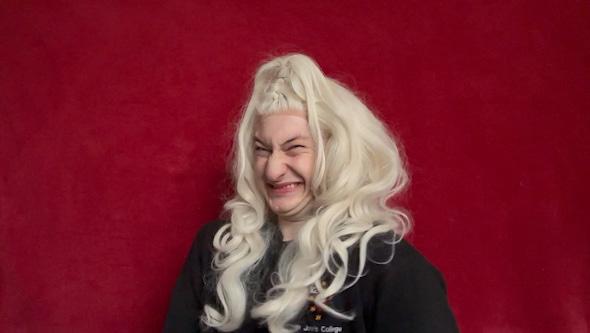
Argument Fallacies
(PART 2)

Straw person
Non sequitur Ad hominem
Hasty or sweeping generalisation
Tu quoque Confusing necessary and sufficient conditions
16 17
LINK >
Critical Thinking Skills: Argument Fallacies (part two)
Author: Lily Middleton-Mansell, English graduate, St John’s College
This is the second half of our Critical Thinking toolbox for identifying argument fallacies, which are common failures or flaws in reasoning that render an argument invalid.
TU QUOQUE
Tu quoque, or “two wrongs don’t make a right’, is when a person turns an allegation back on the person who has accused them. Say your friend accuses you of stealing nail polish from the shop. You would be committing tu quoque if you responded, “but I saw you stealing lipstick the other week!’ This is a fallacy because someone else committing the same wrongdoing as you doesn’t make it right, even if it might make your accuser a hypocrite.
CONFUSING NECESSARY AND SUFFICIENT CONDITIONS
This fallacy is when you assume that something that is necessary for an event to occur is sufficient to make the event occur by itself. If a 16-yearold went to the shop and attempted to buy a bottle of wine, they may complain when prevented from doing so: “but I have enough money to pay for it!” This would be confusing
necessary and sufficient conditions. While having the right amount of money is certainly a necessary condition for buying a bottle of wine, it is not sufficient, because you also need to be over eighteen. This fallacy therefore ignores other factors that may be necessary for something to happen.
HASTY OR SWEEPING GENERALISATION
A generalisation is when you take something specific and apply it broadly. For example, saying “London is a hub for criminal activity”. This can be useful when speaking descriptively, but it becomes a fallacy when it is used to support an inaccurate argument. Just because criminal activity takes place in London, that does not mean that crime is everywhere. A sweeping generalisation is when you use a general principle in a way that ignores its specific exceptions. For example, saying “London is a dangerous place, so I refuse to go to the hospital there” is a fallacy because it ignores the specific boundaries that exist within the general statement - in this case, there may be areas of London with higher crime rates
but actually the hospital is likely to be safe because of its function. A useful way to remember it is that there are exceptions to every rule (although you might notice that this is a generalisation in itself!). A hasty generalisation is when you assume that a particular incident applies to the whole. If you said “someone stole my phone in London – all Londoners are pickpockets!”, that would be a hasty generalisation. This argument is a fallacy because it uses a special case (you came across a pickpocket) as a general rule (therefore all people in London are pickpockets).
STRAW PERSON (ALSO KNOWN AS ‘STRAW MAN’)
You are creating a straw person when you voice the opposing argument in its most extreme or distorted form in order to make it seem less reasonable. Think of it as building a scarecrow of your opposition, which is much easier to fight against than the real thing. Let’s say that you are arguing against a ban on sugary sweets at school. You may say that the school wants to ban sugary sweets because they are against children having fun and want to be able to control everyone’s diets. In fact, the school’s argument is
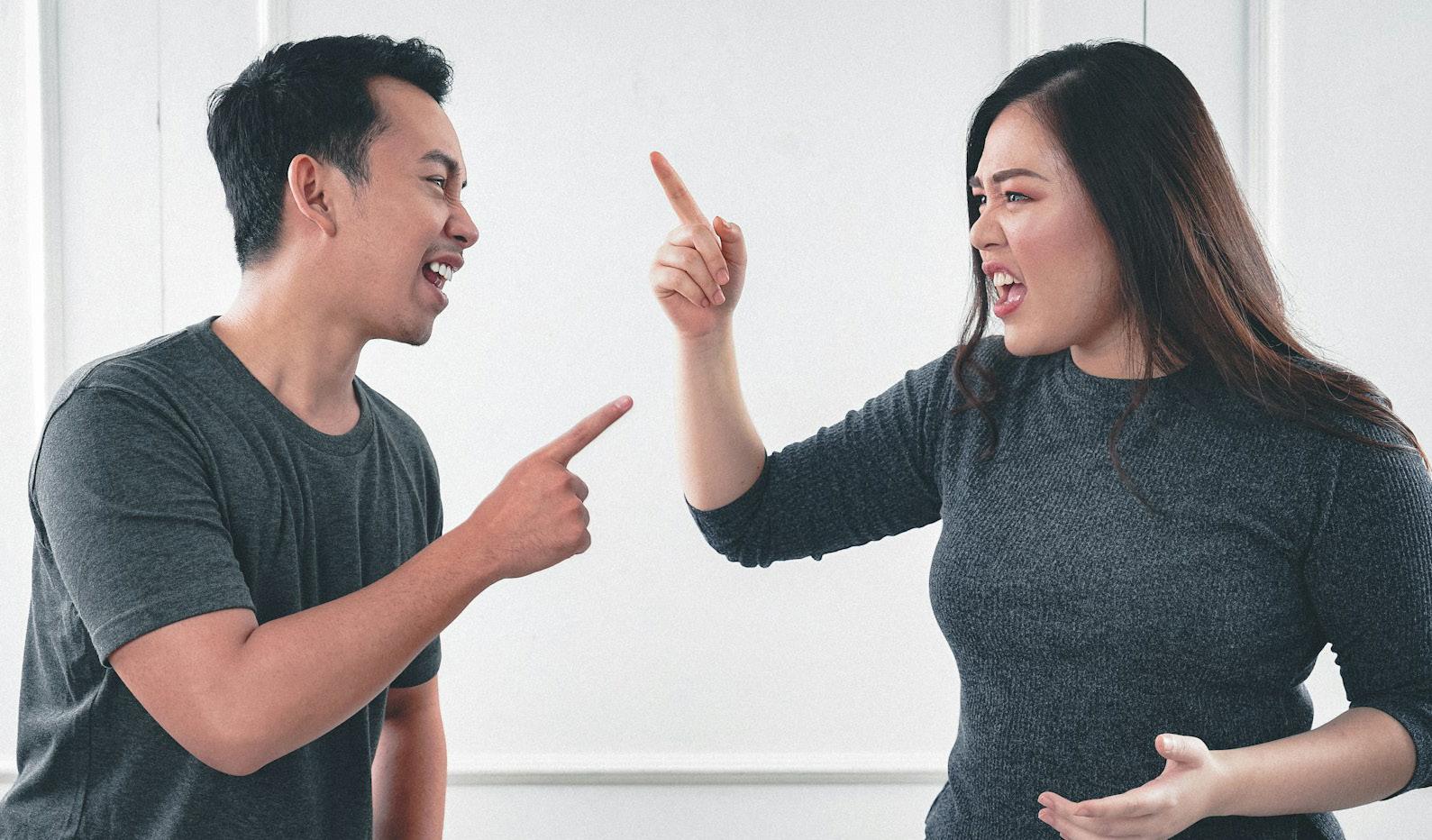
actually that they want to encourage kids to eat healthier by providing more nutritionally balanced snacks instead of sugary ones. There are four key types of straw person arguments: oversimplifying the opposing argument (making a complex issue appear black and white); focusing on just one part of the opposing argument (ignoring the multiplicity of factors at play); taking it out of context (in the case of the sugary sweets, this straw person argument would be that the school wants to control children’s entire diets, while really they just want to provide healthier snacks in school - students can eat what they like at home); and presenting a fringe or extreme version of an opposing argument as the mainstream version of it (for example, claiming that the
MAKE YOUR ARGUMENTS AVOIDING THESE FALLACIES
school believes that sugar should be cut entirely from everyone’s diets, while really most people just want to reduce it). Straw person arguments are fallacies because they misrepresent the opposing view.
AD HOMINEM
Ad hominem is when you make a personal attack rather than critiquing a person’s actual argument. The exchange could go like this: “Jason says that the best route to Brighton is through London.” / “Well, Jason is an idiot.” This is fallacy because, in its attempt to undermine a person’s character, it completely ignores the actual matter at hand.
NON SEQUITUR
A non sequitur is when the conclusion of an argument does not relate to or align with its premises, the assertions that preceded it. For example, a non sequitur would be:
“When I gave up gluten it completely stopped my stomach aches. Therefore you should definitely try giving up dairy.’ The fact that giving up gluten stopped one person’s stomach aches has nothing to do with any benefits that might be found in giving up dairy, therefore the argument does not follow.
18 19
Super Challenge
Now it’s time to identify some fallacies for yourself! Read the passages and answer the questions below, keeping in mind the fallacies that you have learned over the last couple of weeks. You may need to refer back to the Critical Thinking Skills section of last week’s Critical Thinking Workshop as well as this one.
Consider the following argument about homelessness and criminal activity:
Person 1:
The only way to prevent crime amongst the homeless population is to donate to homeless charities, rather than giving to homeless people themselves. They know how to spend the money to get homeless people off the streets and into safer environments, where they no longer have to steal or become involved in illicit business (such as drug dealing) to support themselves. Homeless people are primarily homeless because of drug or alcohol problems, so if you just give them the money, they’ll spend it on fuelling their addictions rather than on food or shelter.
Person 2:
Why would I listen to someone as uneducated and ignorant as you? You clearly just think that homeless people are entirely responsible for their own situation and that they are terrible people who have nothing to offer society at all. These charities are just an inefficient way of giving money to homeless people with all the money they spend on advertising, and it is patronising to take away their autonomy by not giving directly to them. Also, if it’s fine for students across the country to buy and sell illegal drugs, why would it be a problem that homeless people do, too? They reserve the right to make their own choices.
Person 1:
I don’t think you understand the urgency of this issue. If we don’t get this under control now, before we know it, homeless people will form drug networks that bleed into mainstream society and drag vulnerable young people into the depths of crime with them. Homeless people are also aggressive and dangerous – one time, a man on the street incessantly hassled me for money.
1 Match up the following fallacies with quotes from the passage:
1 Tue quoque a Why would I listen to someone as uneducated and ignorant as you?
2 Slippery slope b Homeless people are primarily homeless because of drug or alcohol problems
3 Ad hominem c If we don’t get this under control now, before we know it, homeless people will form drug networks that bleed into mainstream society and drag vulnerable young people into the depths of crime with them.
4 Straw person d Homeless people are also aggressive and dangerous – one time, a man on the street incessantly hassled me for money.
5 Sweeping generalisation e You clearly just think that homeless people are entirely responsible for their own situation and that they are terrible people who have nothing to offer society at all.
6 Hasty generalisation f if it’s fine for students across the country to buy and sell drugs, why would it be a problem that homeless people do, too?
2 Pick one of the quotes and explain, using the descriptions of the fallacies provided at the start of this workshop, why it represents a flaw in the argument.
Below is a passage from an argument about homelessness and re-offending. This passage contains some fallacies:
3a Name the fallacies
3b Explain why the author’s reasoning is flawed. You should refer to the text and clearly show why there is a problem with the author’s reasoning.
People in prison who were previously homeless and return to homelessness after leaving are significantly more likely to reoffend than others. Emma Dore quotes the following in discussing the issue of homelessness and repeated crime, and emphasising the importance of providing stable accommodation to break the circuit:
‘Research has established that securing adequate housing for prison leavers can significantly reduce re-offending. For example, the Social Exclusion Unit found a reduction in relapses into criminal behaviour of 20% when people were given a tenancy, compared to when they were released into homelessness.’
If we rehome the homeless, then, there will be no more instances of reoffending in the UK: those who have been to prison will not commit further crimes because they aren’t homeless.
However, Dore also comments that ‘It is important to note that homeless people are more likely to be victims of crime than perpetrators. 13% of people who became homeless in Scotland in 2018/19 cited a violent or abusive dispute within the household as their main reason for homelessness, with another 4% pointing to fleeing non-domestic violence. In total, this represents 5,895 households.’
Following Dore’s evidence, then, it is clear that homeless people don’t need help from charities at all.
Source cited: Emma Dore, ‘Criminal Justice and Homelessness: Introductory briefing for Prevention Review Group’ (January 2019). https://www.crisis.org.uk/media/241620/criminal-justice-briefingfinal.pdf

20 21



Catching High-Speed Criminals: How Surveillance Technology Helps us Recognise the License Plates of Moving Cars
CATCHING HIGH-SPEED CRIMINALS: HOW SURVEILLANCE TECHNOLOGY HELPS US RECOGNISE THE LICENSE PLATES OF MOVING CARS
Technology
CATCHING HIGH-SPEED CRIMINALS: HOW SURVEILLANCE TECHNOLOGY HELPS US RECOGNISE THE LICENSE PLATES OF MOVING CARS Technology
Commented [KI37]: Title page of cctv
Commented [KI37]: Title
TECHNOLOGY
Author: Mahira Muhsanat, 4th Year Engineering Student, St John’s College
Author: Mahira Muhsanat, 4th Year Engineering Student, St John’s College
Author: Mahira Muhsanat, 4th Year Engineering Student, St John’s College
Engineering plays a key role in the modern fight against crime, especially when it comes to more everyday acts of lawbreaking. License plate recognition is an integral part of modern-day surveillance, particularly when it comes to enforcing speeding laws. In the UK, speeding penalties include an £100 fine and an addition of three penalty points to a driver’s license due to the severe risk posed by speeding motorists to the public. To enforce these essential laws, engineers have developed sophisticated software and advanced image processing techniques to capture and identify number plates in vehicles travelling at high speeds efficiently and accurately.
Types of I mage Distort on
Types of I mage D stortion
We can understand this algebraically. In the equation Ax=y, A represents the original represents the vertical/horizontal filter, and y represents the distorted image. To restore image, we apply the inverse filter to the distorted image to retrieve the original yx
We can understand this algebraically. In the equation Ax=y, A represents represents the vertical/horizontal filter, and y represents the distorted image, we apply the inverse filter to the distorted image to retrieve
We can understand this algebraically. In the equation Ax=y, A represents represents the vertical/horizontal filter, and y represents the distorted image. image, we apply the inverse filter to the distorted image to retrieve the original
Engineering plays a key role in the modern fight against crime, especially when it comes to more everyday acts of lawbreaking. License plate recognition is an integral part of modern-day surveillance, particularly when it comes to enforcing speeding laws. In the UK, speeding penalties include an £100 fine and an addition of three penalty points to a driver’s license due to the severe risk posed by speeding motorists to the public. To enforce these essential sophisticated software and advanced image processing techniques to capture and identify number plates in vehicles travelling at high speeds efficiently and accurately.
Engineering plays a key role in the modern fight against crime, especially when it comes to more everyday acts of lawbreaking. License plate recognition is an integral part of modern-day surveillance, particularly when it comes to enforcing speeding laws. In the UK, speeding penalties include an £100 fine and an addition of three penalty points to a driver’s license due to the severe risk posed by speeding motorists to the public. To enforce these essential sophisticated software and advanced image processing techniques to capture and identify number plates in vehicles travelling at high speeds efficiently and accurately.
Commented [KI38]: Image of license plate
Commented [KI38]: Image
motion blurring due to the camera capturing a moving vehicle; and contrast issues (images being too light or dark), making it difficult to read the license plate. Therefore, we must identify and understand the type of distortion to reverse the distortion.
MOTION BLURRING:
When an image of a vehicle driving at high speeds is first captured, it is likely that the license plate will be illegible due to distortions to the image. To process the image and read the license plate, we first need to understand how the image is distorted.
ROTATIONS:
When an image of a vehicle driving at high speeds is first captured, it is likely that the license plate will be illegible due to distortions to the image. To process the image and read the license plate, we first need to understand how the image is distorted.




Brightness and Darkness Issues:
Brightness and Darkness Issues:
An image can be distorted in various ways, but when concerned with traffic -related distortions, the main types are: image rotations; motion blurring due to the camera capturing a moving vehicle; and contrast issues (images being too light or dark), making it difficult to read the icense plate. Therefore, we must identify and understand the type of distortion to reverse the distortion.
Rotat ons:
Rotations:
Usually, cameras are not placed in the most convenient places to capture the best angle; therefore, some images will be captured rotated. Rotations are the simplest distortion to fix. You simply estimate the angle of rotation and then rotate the image back by the same angle.
Brightness and Darkness Issues:
An image can be distorted in various ways, but when concerned with traffic -related distortions, the main types are: image rotations; motion blurring due to the camera capturing a moving vehicle; and contrast issues (images being too light or dark), making it difficult to read the license plate. Therefore, we must identify and understand the type of distortion to reverse the distortion.
Usually, cameras are not placed in the most convenient places to capture the best angle; therefore, some images will be captured rotated. Rotations are the simplest distortion to fix. You simply estimate the angle of rotation and then rotate the image back by the same angle.
TYPES OF IMAGE DISTORTION
Figure 1 is rotated by 227 degrees, and we can simply rotate it back to retrieve the original image.
Usually, cameras are not placed in the most convenient places to capture the best angle; therefore, some images will be captured rotated. Rotations are the simplest distortion to fix. You simply estimate the angle of rotation and then rotate the image back by the same angle.
Figure 1 is rotated by 227 degrees, and we can simply rotate it back to retrieve the original image.
When an image of a vehicle driving at high speeds is first captured, it is likely that the license plate will be illegible due to distortions to the image. To process the image and read the license plate, we first need to understand how the image is distorted.
Figure 1 is rotated by 227 degrees, and we can simply rotate it back to retrieve the original image.
An image can be distorted in various ways, but when concerned with traffic-related distortions, the main types are: image rotations;
Motion B urr ng:
Motion Blurring:


Brightness and darkness issues can be adjusted using something understand point operations, we must understand how images continuous, but rather a 2D array of pixels. When dealing with a value represents the intensity for that pixel. For storage as a digital pixel. This results in 256 integer levels (28) ranging from 0-255. So, between 0-255 depending on how light or dark they are; Figure black is zero and white is 255. To represent a colour image, three each primary colour: red, green, and blue which then requires scale of 224 pixels.

Filters can relate to physical movement. The example in Figure 2 shows the effect of a vertical filter and a horizontal filter. Applying a horizontal filter to the image can cause horizontal motion blur, and the same happens with a vertical filter. To reverse the effect, we simply apply the inverse of the filter to the distorted image to retrieve the original image. We can understand this algebraically. In the equation Ax=y, A represents the original image, x represents the vertical/horizontal filter, and y represents the distorted image. To restore the original image, we apply the inverse filter to the distorted image to retrieve the original yx-1 = A.
Brightness and darkness issues can be adjusted using something called point operations. understand point operations, we must understand how images are formed. An image continuous, but rather a 2D array of pixels. When dealing with a grayscale image, value represents the intensity for that pixel. For storage as a digital file, we typically pixel. This results in 256 integer levels (28) ranging from 0-255. So, each pixel can take between 0-255 depending on how light or dark they are; Figure 3 shows an example. black is zero and white is 255. To represent a colour image, three values are stored each primary colour: red, green, and blue which then requires 24 bits per pixel, scale of 224 pixels.
Brightness and darkness issues can be adjusted using something called point understand point operations, we must understand how images are formed. continuous, but rather a 2D array of pixels. When dealing with a grayscale value represents the intensity for that pixel. For storage as a digital file, we pixel. This results in 256 integer levels (28) ranging from 0-255. So, each pixel between 0-255 depending on how light or dark they are; Figure 3 shows an black is zero and white is 255. To represent a colour image, three values are each primary colour: red, green, and blue which then requires 24 bits per scale of 224 pixels.
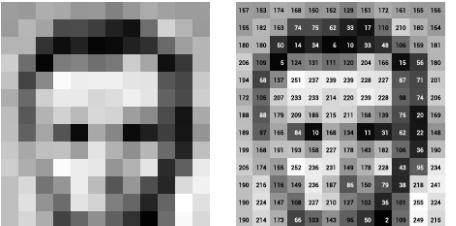
Point operations can change contrast and brightness by transforming pixel their distribution. They can assign a new intensity value to all pixels having
Point operations can change contrast and brightness by transforming pixel intensities their distribution. They can assign a new intensity value to all pixels having a particular
Point operations can change contrast and brightness by transforming their distribution. They can assign a new intensity value to all pixels
We can understand this graphically:
We can understand this graphically:
Filters can relate to physical movement. The example in Figure 2 shows the effect of a vertical filter and a horizontal filter. Applying a horizontal filter to the image can cause horizontal motion blur, and the same happens with a vertical filter. To reverse the effect, we simply apply the inverse of the filter
We can understand this graphically:
Filters can relate to physical movement. The example in Figure 2 shows the effect of a vertical filter and a horizontal filter. Applying a horizontal filter to the image can cause horizontal motion blur, and the
If an image is overall too dark and we want to brighten the image, we can simply increase
If an image is overall too dark and we want to brighten the image, we can
22 23
with a vertical filter. To reverse the effect, we simply apply the inverse of the filter
same happens
If an image is overall too dark and we want to brighten the image,

this algebraically. In the equation Ax=y, A represents the original image, x vertical/horizontal filter, and y represents the distorted image. To restore the original inverse filter to the distorted image to retrieve the original yx-1 = A.
Point operations can change contrast and brightness by transforming pixel intensities and changing their distribution. They can assign a new intensity value to all pixels having a particular original value.
BRIGHTNESS AND DARKNESS ISSUES:
We can understand this graphically:
For example, if you used the function γ=0.004 as shown in Figure 5, the really dark pixels in your image would be made lighter while the lighter pixels would remain light, so the overall effect would be that the image is brightened significantly.
For example, if you used the function γ=0.004 as shown in Figure 5, the really dark pixels in your image would be made lighter while the lighter pixels would remain light, so the overall effect would be that the image is brightened significantly.
For example, if you used the function γ=0.004 as shown in Figure 5, the really dark pixels in your image would be made lighter while the lighter pixels would remain light, so the overall effect would be that the image is brightened significantly.

ss Issues:
Brightness and darkness issues can be adjusted using something called point operations. Before we understand point operations, we must understand how images are formed. An image is not continuous, but rather a 2D array of pixels. When dealing with a grayscale image, a single numerical value represents the intensity for that pixel. For storage as a digital file, we typically use 8 bits per pixel. This results in 256 integer levels (28) ranging from 0-255. So, each pixel can take a value between 0-255 depending on how light or dark they are; Figure 3 shows an example. By convention, black is zero and white is 255. To represent a colour image, three values are stored — one each for each primary colour: red, green, and blue — which then requires 24 bits per pixel, which makes a scale of 224 pixels.
If an image is overall too dark and we want to brighten the image, we can simply increase the intensity of all pixels by mapping them onto a higher number as shown in Figure 4. The x-axis represents the original value of the pixel, and the y-axis represents the new (higher) value of the pixel. The effect of this point operation will be that the image will appear overall brighter.

x-axis represents the original value of the pixel, and the y-axis represents the new (higher) value of the pixel. The effect of this point operation will be that the image will appear overall brighter.
pixels would remain light, so the overall effect would be that the image is brightened significantly.
Figure 6 shows the effect of other ���� values on an image:
Figure 6 shows the effect of other ���� values on an image:
Figure 6 shows the effect of other ���� values on an image:
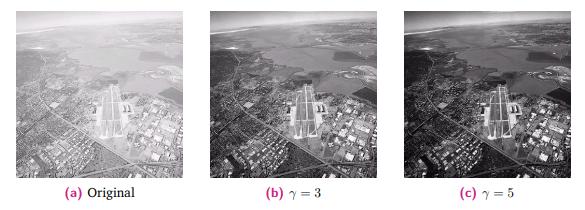

Think piece:
Think piece:


the police to have access to license plate images within seconds of the driver speeding past the camera.
This license plate number can then also be read by these robust algorithms and compared to a database that identifies the driver responsible for the offense. The database will also store the driver’s details, allowing the police to issue relevant warning letters and penalties to drivers quickly and efficiently.
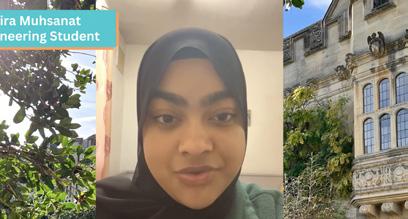
Think piece:
darkness issues can be adjusted using something called point operations. Before we operations, we must understand how images are formed. An image is not a 2D array of pixels. When dealing with a grayscale image, a single numerical intensity for that pixel. For storage as a digital file, we typically use 8 bits per 256 integer levels (28) ranging from 0-255. So, each pixel can take a value depending on how light or dark they are; Figure 3 shows an example. By convention, white is 255. To represent a colour image, three values are stored one each for red, green, and blue which then requires 24 bits per pixel, which makes a

What do you think the effect of using ���� = 25 will be? Can you explain this using the graph in figure 5?
What do you think the effect of using ���� = 25 will be? Can you explain this using the graph in figure 5?
What do you think the effect of using ���� = 25 will be? Can you explain this using the graph in figure 5?
Image Editing and Automation
In the example in Figure 4, since all pixel intensities are increased by the same amount, we can say that this is a linear operation. However, we can also apply nonlinear operations, and they can have different effects on the image. Figure 5 shows various other functions you can apply to the original image; each will have a different effect. These are the power law transformations, where the original pixels are accentuated according to the power γ , (original pixel)^γ = output pixel.
Image Edit ng and Automation
Image Editing and Automat on
Think piece:
It is evident that image editing can be a tedious process. It can be quite time-consuming when done manually. To add to the complexity, each image will be subject to multiple distortions, so to retrieve the original image, the editor will need to reverse each distortion in the best order to achieve the results the quickest.
It is evident that image editing can be a tedious process. It can be quite time-consuming when done manually. To add to the complexity, each image will be subject to multiple distortions, so to retrieve the original image, the editor will need to reverse each distortion in the best order to achieve the results the quickest.
According to the RAC Foundation, there are 40.8 million licensed drivers in the UK, so finding one can be like finding a needle in a haystack. But through advanced software systems, it can be done in seconds, making our roads safer and enforcing the law effectively.
Commented [KI39]: Green box with thought bubble icon
Commented [KI39]: Green box with thought bubble icon
It is evident that image editing can be a tedious process. It can be quite time-consuming when done manually. To add to the complexity, each image will be subject to multiple distortions, so to retrieve the original image, the editor will need to reverse each distortion in the best order to achieve the results the quickest.
What do you think the effect of using γ=25 will be? Can you explain this using the graph in figure 5?
This is where engineers can help. Image editing has been done for many years; therefore, engineers have developed extensive software that automatically processes these images in the fastest way possible, allowing the police to have access to license plate images within seconds of the driver speeding past the camera.
This is where engineers can help. Image editing has been done for many years; therefore, engineers have developed extensive software that automatically processes these images in the fastest way possible, allowing the police to have access to license plate images within seconds of the driver speeding past the camera.
This is where engineers can help. Image editing has been done for many years; therefore, engineers have developed extensive software that automatically processes these images in the fastest way possible, allowing the police to have access to license plate images within seconds of the driver speeding past the camera.
In the example in Figure 4, since all pixel intensities are increased by the same amount, we can say that this is a linear operation. However, we can also apply nonlinear operations, and they can have different effects on the image. Figure 5 shows various other functions you can apply to the original image; each will have a different effect. These are the power law transformations, where the original pixels are accentuated according to the power ���� , (�������������������������������� ��������������������)/ = output pixel.
This license plate number can then also be read by these robust algorithms and compared to a database that identifies the driver responsible for the offense. The database will also store the driver's
This license plate number can then also be read by these robust algorithms and compared to a database that identifies the driver responsible for the offense. The database will also store the driver's
This license plate number can then also be read by these robust algorithms and compared to a database that identifies the driver responsible for the offense. The database will also store the driver's
change contrast and brightness by transforming pixel intensities and changing They can assign a new intensity value to all pixels having a particular original value.
this graphically:
too dark and we want to brighten the image, we can simply increase the by mapping them onto a higher number as shown in Figure 4. The x original value of the pixel, and the y-axis represents the new (higher) valu point operation will be that the image will appear overall brighter.
Point operations can change contrast and brightness by transforming pixel intensities and changing their distribution. They can assign a new intensity value to all pixels having a particular original value. We can understand this graphically:
If an image is overall too dark and can simply increase the intensity of all pixels by mapping them onto a higher


IMAGE EDITING AND AUTOMATION
For example, if you used the function γ=0.004 as shown in Figure 5, the really dark pixels in your image would be made lighter while the lighter pixels would remain light, so the overall effect would be that the image is brightened significantly.
Figure 6 shows the effect of other ���� values on an image:
For example, if you used the function γ=0.004 as shown in Figure 5, the really dark pixels in your image would be made lighter while the lighter
It is evident that image editing can be a tedious process. It can be quite time-consuming when done manually. To add to the complexity, each image will be subject to multiple distortions, so to retrieve the original image, the editor will need to reverse each distortion in the best order to achieve the results the quickest. This is where engineers can help. Image editing has been done for many years; therefore, engineers have developed extensive software that automatically processes these images in the fastest way possible, allowing
Commented [KI39]: Green box with thought bubble icon
Super Challenge
As a final challenge can you identify what steps you might take to identify the number plate on the image below:
Present your steps as a flow diagram and explain each step carefully.

24 25
SUMMARY VIDEO > LINK >
Alfred Dreyfus

Emile Zola and the 1894 Dreyfus Affair: Can Literature Confront Social Injustice?
HISTORY AND FRENCH
Author: Liz Tiskina, 4th Year History and French student, St John’s College

France at the close of the 19th century was a divided country, with a complicated idea of what it meant to “belong” in French society. After all, since the Revolution of 1789 and the establishment of the First Republic, the country had undergone a series of radical political and social changes, taking the country from revolutionary democracy, to empire and back again, multiple times. By 1894, France was governed by the Third Republic (18701940), which was set up in the wake of the Franco-Prussian war. The 1894 Dreyfus Affair brought to light the entrenched issues in French society that had not been stabilised by the establishment of the Third Republic: militaristic nationalism, antisemitism, and corruption within the state. The response and backlash that the Dreyfus Affair inspired in French society – particularly from novelist Émile Zola – can teach us about
the real social power that literary movements can hold.
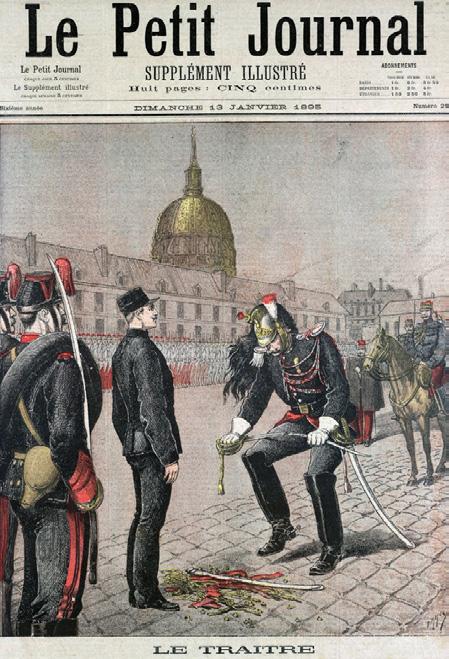
a torn-up slip of paper, confirming that French classified documents had been passed onto the Germans. Dreyfus’s supposed guilt was almost entirely constructed on a dubious handwriting analysis from this piece of paper, and he was sent into exile in 1895 on the Devil’s Island, in French Guiana. There he suffered disease and mistreatment by guards.
Dreyfus was an easy scapegoat: he knew multiple languages, was a curious and inquisitive officer, and was Jewish. He could easily be presented as an “other”, an outlaw, precisely because he could easily be painted as an enemy to an unforgiving and antisemitic standard of “Frenchness”.
The Dreyfus Affair became much more broadly socially significant than the legal case which sparked it. The initial issue was the condemnation of a Jewish army captain (Alfred Dreyfus) who had been accused of treasonous spying for the German government. The key piece of evidence in the case was a bordereau,
Many in French society were outraged by the mistreatment of Dreyfus and the farcical, opaque nature of his trial. In this period there was already a significant base of French people critical of the military and the Catholic church. While we must be careful not to generalize too
26 27
VIDEO > LINK >
SUMMARY
broadly, it was common that anticlerical, anti-militarist sentiment was beginning to be pitted against nationalism and traditionalism. While nationalism in French society was often tied to left-wing patriotism after the 1789 Revolution, its connection to the power of the Catholic Church soon meant it became resented by the Left.

Emile Zola

suffering of society’s poorest into harsh light. His novel l’Assommoir, for example, tells the story of an impoverished washerwoman living in the drunken underbelly of Paris. Zola argued that the novel could become an “instrument of […] social discoveries”, a real tool that can explain the constant complex interplay of cause and consequence which determine problems in society.
Super Challenge
To fully understand the power of J’accuse…!, consider how Zola uses language in the following passages. Below are some sentences taken from his work. Answer the questions linked to each extract.
The state of inequality in French society was beginning to be brought to light and was deplored by many artists and novelists at the time. In this period, the Naturalist movement in art aimed to represent the present reality of society without any idealism (this was in part a reaction to the earlier Romantic movement). The term ‘Naturalist’ was coined by Émile Zola, whose novels – most importantly, the twenty novels in his Rougon-Macquart cycle – put the
On the 13th January 1898, four years after Dreyfus’s initial arrest, an open letter appeared in l’Aurore, a liberal Parisian newspaper, under the headline “J’accuse…!”. It was penned and signed openly by Zola, who by this point had published many of his most popular works. The contents of this letter were unprecedentedly, unashamedly critical of the military and those who had overseen Dreyfus’s case. Zola openly addressed the President of the republic, Felix Fauré, and implored him to bring those responsible to justice. Zola even clearly accepted that he was exposing himself to the danger of being punished by law for defamation.
Near the beginning of his letter, Zola explains the outlines of the Dreyfus case and justifies his anger with the following lines:
Si j’insiste, c’est que l’œuf est ici, d’où va sortir plus tard le vrai crime, l’épouvantable déni de justice dont la France est malade.
a) What does Zola mean by “l’oeuf est ici?”
Zola exposes those who he accuses of having covered up proofs of Dreyfus’s innocence:
Comprenez¬-vous cela ! Voici un an que le général Billot, que les généraux de Boisdeffre et Gonse [generals in charge of Dreyfus’s trial] savent que Dreyfus est innocent, et ils ont gardé pour eux cette effroyable chose Et ces gens¬-là dorment, et ils ont des femmes et des enfants qu’ils aiment !
b) What rhetorical device does Zola use to highlight the wrongdoing of these generals?
While Zola’s letter is highly factual and references detailed specificities in the case, he still uses beautifully crafted literary lines:
Ô justice, quelle affreuse désespérance serre le cœur !
c) Translate this line – how would you tackle the abstract imagery of “serre le coeur”?
Zola was, as he predicted in his letter, brought to trial for libel in February 1898 and sentenced to prison and a fine. The letter, however, became a catalyst for public anger against Dreyfus’s mistreatment; it neatly and passionately compiled all the problems surrounding the case into one powerfully crafted piece of writing. More than simply encouraging public interest in the case, Zola condemned the broad patterns of injustice in a society which was striving to make itself known for “[…]labour, truth, and liberty” (“[…]qui couronnera notre grand siècle de travail, de vérité et de liberté”). More than simply condemning the corruption of army officials, Zola unmasked those he accused to be “spirits of social wrongdoing”, manifested symbols of societal discontent. Zola harnessed his literary theory of Naturalism and employed it to effectively expose the hidden corruptions of the military and the state. Dreyfus was eventually “pardoned” in 1899 after a second trial (though he was found guilty again); he was fully exonerated in 1906.
Want to find out more?
LINK >
LINK >
● Watch this video for some more detail on the Dreyfus Affair
● If you’d like to challenge yourself to look at the whole of J’Accuse, you can find an English translation and the original French at this link
28 29
J’Accuse...!
£ ⚖

The Cost of Crime
ECONOMICS
Author: Hazal Bulut, PPE graduate, St John’s College
What constitutes a crime is determined by law, and the line between crime and legal right can move either way with new legislation. With that, the anticipation of criminalised acts, the response to them, and their consequences often incur social, political, and economic costs. In this article, we will focus on the economic side of things by first looking at the financial cost of crime and then by considering the relationship between economic conditions and punishment.
The Home Office published a report in 2018 reflecting on the cost of crime in 2015-16 in England and Wales. According to this report,
the overall cost of crime to individuals for 2015-16 was £50 billion, and the overall cost to businesses was £9 billion.
These are huge figures - so let’s look at how the Home Office worked out the costs. They looked at the spending in anticipation of a crime, the costs as a consequence, and the costs of responding to crime.
Firstly, the Home Office considers the spending in anticipation of
crime. This includes general building security, vehicle security, and private security measures. Costs like cyber security and the administration of insurance pay-outs are also included. We can discuss whether the spending in anticipation of crime should be included in the cost of crime, as such measures have become separate private industries that generate further income and are not necessarily a public spending burden; as such, their inclusion may overinflate the result.
Secondly, the costs of crime figures discussed above include the consequences of crime. The Home Office puts in this category the costs of stolen or damaged property, physical and emotional harm to victims, health service costs, and lost output due to the time victims take off work. This is more akin to what comes to mind when considering the economic cost of crime - the direct consequences.
Thirdly, the costs in response to crime are included in the total figure. This means the police and criminal justice system costs - the costs relating to the courts functioning, the juries taking time off work, and the cost of imprisoning people. It is essential to
mention that many people advocate for reforming or abolishing these systems, and while this might be too big of a topic to delve into here, it is relevant to mention that these objections assert that the institutions in place do not work despite costing billions of pounds to uphold. Hence, acknowledging that the existing responses are often regarded as neither sufficient nor necessary is essential when we mention the cost of responding to crime.
While until now, we have discussed the different ways of looking at the financial cost of crime, we will now consider how economics intersects with the punishment of crime - or, to continue using the Home Office report’s terminologythe response to crime.
“Tackling crime” or “being harsh on crime” is an oft-used promise by political candidates as it seems to show resolve and principle - yet the reality of responding to crime demonstrates that this promise is not as straightforward as it may sound.
The response to crime is determined by the law as well. Thus, the institutions in place and how communities are policed are not given or fixed. When we see how the
30 31
☹
criminal justice system approaches different offenders, a disturbing trend is seen: poorer socio-economic groups are over-represented in the criminal justice system. This is even more pronounced when poverty is combined with other factors, such as having a minority ethnic background or mental illness.
Dr Marianne Wade, Reader in Criminal Justice at Birmingham Law School, says: “We tend to talk about crime as if it is some unitary category and as though our response to it is entirely rational. In reality, our criminal justice system is the result of a near-unbroken 800-year history of laws and agencies that have built up and, predictably, carried over some of the discriminatory social attitudes of their founders.”
This leads to what legal advocates call the criminalisation of poverty. Non-payment of council tax may result in prison for up to three months, and many end up in jail due to poverty-driven crimes such as stealing food or baby products, while ‘white-collar’ crime like tax evasion is often punished relatively less harshly. Police forces across England and Wales are still prosecuting people for begging and rough sleeping under the Vagrancy Act - a law that came into force in 1824. Economic conditions, intersecting with other relevant factors, result in homelessness for many. Instead of having systems in place to address these complex issues and help the already vulnerable, institutions instead arrest or move them, and seize their belongings. Then, the money spent arresting and policing the homeless gets included in reports as part of the cost of crime. Thus, crime is a politically-loaded word, and when we discuss the financial cost of it, acknowledging that
Super Challenge
Look at the crime section of a physical or online newspaper and select 3 or 4 reports on crimes that have been committed. Using the information in this article to give you some ideas, write a breakdown of what costs might be involved in those crimes and then explain in no more than 200 words what you have found out when comparing each case?
whose actions are considered criminal is also related to economic conditions is important.

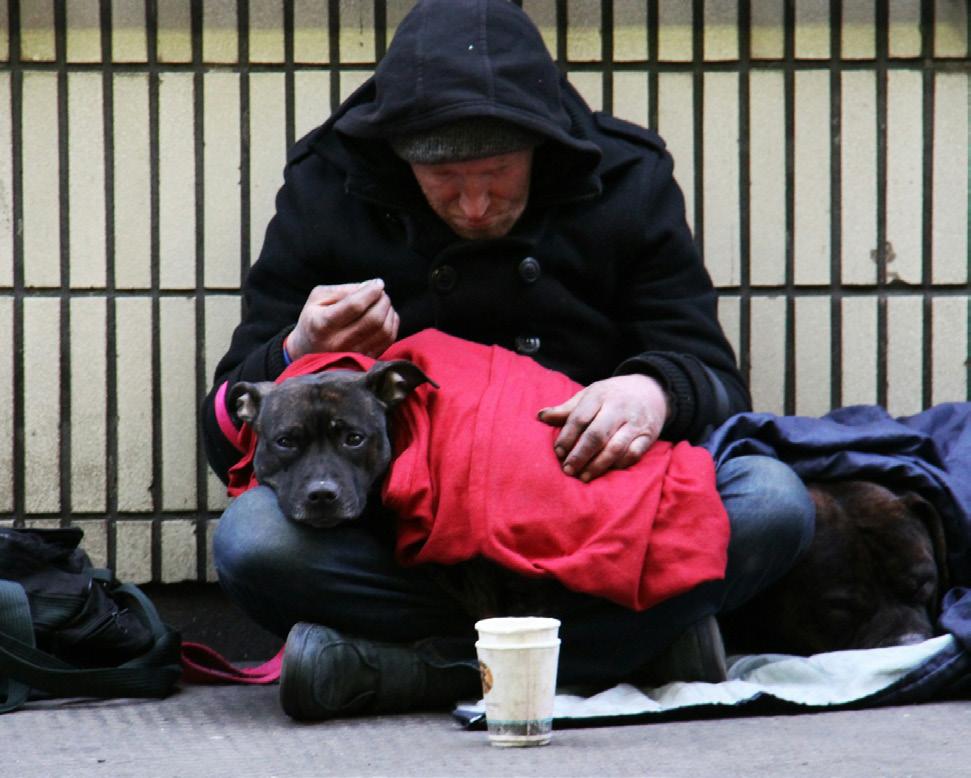

INSPIRE CRITICAL THINKING SUMMER SCHOOL FOR YEAR 11
Are you looking for something fun and CV-boosting to do this summer? Then why not apply to our Inspire Critical Thinking (Year 11) Summer School!
Our Inspire Summer Schools offer you the opportunity to experience life as an Oxford student by staying in St John’s Halls of Residence, taking part in exciting academic sessions, and getting involved in fun extra-curricular activities! The Year 11 Inspire Summer School programme includes:
• Exciting academic sessions in a range of subjects
• A lecture from Dame Professor Sue Black
• A Garden BBQ and Formal Dinner in our beautiful Hall
• Theatre performances, punting, museum trips and more!
The Inspire Critical Thinking (Year 11) Summer School will take place Monday 29th of July – Thursday 1st August, and is entirely free of charge.
Applications will open later in the Critical Thinking cycle and we will consider your engagement with the Critical Thinking workshops (submitting super challenges) as well as contextual information as part of your application.

33 32
VIDEO
LINK >
SUMMARY
>
DNA Fingerprint

Criminal Record: Tracking DNA Fingerprints
FORENSIC SCIENCE
Author: Dame Professor Sue Black, President of St John’s College
DNA has become synonymous with the world of forensic investigation but of course, this is a relatively recent development.
Sir Alec Jeffreys was working on medical genetics in Leicester University in 1984 and was becoming increasingly frustrated at his inability to understand why some of his experiments were not working. Then he had a ‘eureka’ moment, not everybody’s DNA was the same. The influence of this realisation on criminal investigations cannot be overstated and today, every jury expects there to be DNA evidence that will confirm or refute the innocence or guilt of those accused. The first forensic case to utilise his theory was in a disputed immigration case for a child from Ghana and then the work assisted in the prosecution and conviction of Colin Pitchfork for the murder of two teenage girls in the 1980’s.
How do we find a DNA sample to compare with one found at the crime scene? The UK holds a national DNA database (NDNAD) which was set up in 1995 and contains over 6
million profiles primarily of those convicted of an offence or awaiting trial.
The value of searching via familial DNA was illustrated in the case of James Lloyd, who was convicted of several assaults after his sister’s DNA appeared on the database following a drink-driving offence. Even more recently the use of genealogical or next-generation DNA matching gained notoriety following the successful prosecution of Joseph DeAngelo in 2020 in what became known as the Golden State murders. This is not an avenue that UK police are currently permitted to pursue due to legislation.
HOW DOES THE DNA GET LEFT AT A CRIME SCENE?
We need to remember Edmund Locard’s principle which purports that ‘every contact leaves a trace’. But how reliable is a trace of DNA and how much needs to be present for us to be confident in our assertions?
LCN DNA (low copy number) or LT DNA (low template) refers to any situation where there is only a small amount of DNA present, typically less than 100-200pg of total DNA
available for amplification. With such sensitivity it would suggest that results can be gained from smaller and smaller samples of material.
But caution, in 2007 Sean Hoey was cleared of 56 charges as the trial for the Omagh bombings collapsed because of concern over LCN DNA and both the limited scientific understanding and the processes and procedure adopted at that time.
With the recent advances in technology now, we know that we can target and extract DNA from a single cell.
But do we know how that cell came to be in that location and whether it is relevant to the crime? Imagine you are at a party. The music is loud. Everyone is singing at the top of their voices. The place is hot. Everyone is sweating and clothing is light. It is likely that when you leave that party, both you and your clothing will carry DNA from multiple people who were around you that night either from the saliva in the air, the touch of their bodies on the dancefloor or the spray of sweat as everyone moved to the music. Should something happen to you on your
34 35
way home and you and your clothing are swabbed by the police, the DNA of multiple people will be detected and one of those may be a person of interest – but how do we tell which one and how confident can we be?
Some people are known to be ‘shedders’ in that they lose a lot of their skin cells or produce a lot of saliva or sweat and so they are likely to be over-represented compared to others. We know very little of how DNA is transferred from one person to another or indeed on to a third party through secondary transference. We also don’t know how long DNA persists on different materials once it has been transferred. So, transfer and persistence are big problems for DNA analysis in determining whether the material is of relevance or is contamination.


● About Alex Jeffreys and DNA fingerprinting [WARNING: this article contains mentions of sexual abuse]
● Explaining Edmond Locard’s Exchange Principle
Whilst technology has advanced our ability to identify, extract and amplify increasingly small volumes of often-degraded DNA, the context is everything and that will become the focus from opposing legal counsel when cross examined.
Have your say
Do you think modern techniques of crime detection, such as fingerprint and DNA analysis, should be used in unsolved cases from previous decades? What might be the repercussions of doing this and is it worth it?
● About the 2020 Golden State Killer
Super Challenge
Think about what you did yesterday. Draw a chart demonstrating the different places you went, what you would have touched and where your DNA could have gone after that (example below). Keep in mind the different ways that DNA can travel: skin cells, hair roots, blood, sweat, saliva and other bodily fluids. Push yourself to imagine how far your DNA can go!


Trial by TikTok

37 36
LINK > LINK
LINK
>
>
LINK
>
Trial by TikTok: The Social Media Judgements of Johnny Depp and Amber Heard
POLITICS
Author: Lily Middleton-Mansell, English graduate, St John’s College
This article was written to be a little more challenging, either in content, theme or style – give it a go if you want to push yourself even further.
The rise of social media means that, while legal judgement may be confined to the courts, the voice of public opinion often drowns out or distorts the lawyers’ debates.
The impact of media coverage on jurors has become the centre of increasing concern about the ability to have a fair trial in the modern age of mass media, where jurors can easily access thousands of opinions online that often pay little regard to factual evidence and are hidden from accountability by the protection of the keyboard or phone screen. The prominence of social media debate about certain cases means that the collection of non-contaminated evidence and the selection of a jury who have little to no outside knowledge of the case is difficult beyond the provisions of the 1981 Contempt of Court Act, which seeks to protect legal proceedings against media publicity. Commenters have expressed concern about a new phenomenon of trial by social media
that is akin to trial by mob rule. This new focus on online mass anger not only risks negatively impacting the due process of a court case. It also eclipses the more sympathetic side of public opinion, giving a twisted perception of an uncompassionate public. The disappearance of Arazia Chamberlain, a nine and a half week old camping with her family in Australia, triggered a huge wave of accusations against both of her parents, Michael and Lindy, but focused on her mother in particular. Arazia’s parents believed that their daughter had been eaten by a dingo (an Australian wild dog) but the media perpetuated suggestions that they had murdered Arazia, an opinion often accompanied by misogynistic abuse. After a very long trial, the couple were exonerated in 1988. However, the lasting impression of the negative media frenzy remained. Thousands of public letters written to Lindy demonstrate a much more open-minded and sympathetic public perception of the incident. But such responses are overwhelmed by the louder, negative reactions of what is often a smaller group than it seems. This means that, both in the court of law and the court of public opinion,
the magnifying impact of mass media can distort judgements about a case. The effect of mass media in the 1980 case of Arazia Chamberlain anticipates the increasing impact of social media on more recent trials.
The 2022 Johnny Depp and Amber Heard defamation case encapsulates the extent to which social media, particularly sites such as Twitter and TikTok, can exacerbate public rage about a trial. In the case, Johnny Depp was claiming defamation for a 2018 Washington Post article in which Heard described herself as a victim of domestic abuse. While Heard never mentioned Depp by name, he argued that he was implicated by her presentation of herself as a victim. His arguments attempted to prove that Heard herself had been the instigator of the violence and that her allegations were a ‘hoax’. But his aim went beyond legal compensation: the trial represented an attempt by Depp to reclaim a reputation and career that were damaged by other assault accusations and when Heard took out a temporary restraining order against him in 2016. Depp was not only waging a legal battle; he was also trying to win the court of public opinion. Even if he lost the case, he
could still regain a successful career as an actor and public figure.
A 2020 libel trial in the UK, in which Depp sued News Group Ltd over an article in The Sun which described Depp as a ‘wife-beater’, ruled against Depp, with the presiding judge stating that the ‘great majority of alleged assaults of Ms. Heard by Mr Depp has been proved to a civil standard.’ However, despite this precedent, and the fact that both Depp and Heard claimed to be victims of domestic violence in the 2022 trial, a study of TikTok memes and views indicates a clear bias towards Depp. Many critics have questioned the decision to livestream the trial, a choice that Depp supported and Heard argued against. The broadcast attracted large numbers of viewers and considerable social media response. While the function of the livestream was to make the events of the trial more accessible without disrupting its actual proceedings (due to its highly public status, opening the trial to journalists would have been quite chaotic), the existence of the broadcast arguably exacerbated the spread of misinformation about the case.
The social media response, which often included edited videos and pictures from the trial, contained significant amounts of harassment and misinformation about Heard. Researchers even identified bots artificially spreading content, including false allegations such as the idea that Heard copied quotes from The Talented Mr Ripley in her testimony. The conservative website The Daily Wire spent between $35000 and $47000 on Facebook
and Instagram advertisements to promote misleading information and anti-Heard propaganda. Twitter trolls also carried out rampant abuse and harassment of women who expressed support for Heard. Many commentators have interpreted this public response as a reaction against women’s rights campaigns, in particular a misogynistic backlash to the #MeToo movement, something that Heard’s initial Washington Post article was written to support.
The outcome of the trial came as a surprise to many analysts who, due to its UK precedent and the predominance of freedom of speech protections in the US, had expected it to conclude in Heard’s favour. However, the jury ruled that Heard’s references to sexual violence and domestic abuse in The Washington Post were false and defamed Depp with actual malice, awarding Depp $10 million in compensatory damages and $5 million in punitive damages from Heard. The extent to which the social media trial of Amber Heard impacted the jury’s final decision is hard to determine. Heard’s attorneys suggested that, because the jury was not sequestered (isolated from outside contact during the trial proceedings), the social media coverage of the trial may have inflamed the final verdict. However, the full impact of a jury’s human error (often an inevitable flaw) is impossible to calculate.
Beyond the influence of social media on a jury, the live broadcasting of the trial is a key topic of debate. Feminist and domestic violence groups considered the verdict a setback for victims of domestic abuse and condemned defamation suits
as a way to threaten and silence survivors. The broadcasting of the trial took a hugely sensitive topic and transformed it into a worldwide sensation comparable to reality TV, making all involved vulnerable to public abuse.
Do you think trials should be live streamed to the public?
Have your say
Consider the advantages and disadvantages of livestreaming trials. What balance is there to be made between making the legal system publicly accessible, and protecting the people directly involved in the case? Is there a way to make high status trials public without sensationalising them? Can the truth of a trial be publicly protected in the age of social media?
38 39
X Vote Now

Watch Alfie and Azeez discussing trial by social media here
Want to find out more?
● Should Trump’s trial be televised?
● UK v. US Johnny Depp and Amber Heard case
● Gucci Controversy: Blackface, Cultural Appropriation And Pro Choice Empowerment
● Gucci’s blackface design controversy is about racism, not ignorance
Super Challenge
Write a plan for a debate arguing either for or against the livestreaming of legal trials. Include an introduction, at least three main points, at least three rebuttals and a conclusion. A rebuttal is where you argue against one of the other team’s points. In order to plan your rebuttals in advance, think about what the main points of the opposing argument might be and consider what you would say against them. As an extension, write three rebuttals that the opposing team might make against your own arguments. If you try to anticipate the flaws in your own arguments in advance, it makes it easier to defend yourself against criticism when it comes to an actual debate. If you get the chance, try doing this debate with your friends!
Hint: Keep in mind the division between criminal trials (involving people who are accused of breaking the law, where cases are usually filed by the government and the court decides whether the person is guilty or not guilty) and civil trials (involving a case where someone wants to bring civil action against or sue someone, where cases are filled by private parties and the court decides whether the person is liable or not liable). Is it the case that some types of trials should be filmed and others shouldn’t?








40 41
SUMMARY VIDEO > LINK >
LINK > LINK > LINK > LINK >
S HT O N OXFORD Ghost Stories

Introducing ... Oxford Ghost Stories
OXFORD SPOTLIGHT
Author: Lily Middleton-Mansell, English graduate, St John’s College
Dating from the eleventh century, the University of Oxford harbours a morbid history, ranging from political executions to devilish gore. Within the ancient stones of the colleges still linger some traces of violence past, echoes where a sudden death has torn through the fabric of time or a bitter soul clings onto its earthly dwelling.
Oxford students and Professors alike are made to confront these echoes in ghostly sightings that still occur today. With around half of the Oxford colleges containing chapels, under which Masters, Fellows and undergraduates would often be buried, Oxford University is not short on skeletons in the closet. However, certain colleges are particularly known for having residents centuries older than the average undergrad.
One of the biggest features on the traditional Oxford ghost tour is our very own St John’s College. William Laud was a close friend of Charles I and was made Archbishop of Canterbury in 1633. During the English Civil War, however, Parliament put him on trial for treason and Laud was eventually beheaded in 1645. While Laud was killed in the Tower of London, his body was laid to rest under the altar in the chapel of St John’s College.
His ghost has since been sighted wandering the corridors of the St John’s College Old Library, carrying a candle and kicking his severed head across the floor.
The Old Library has been closed for the past three years, undergoing vital renovations, so recently there has been little in the way of hauntings beyond the occasional creepy atmosphere in the college gardens next door. But the library reopened in October 2023. Perhaps this is the perfect opportunity for the headless ghost of William Laud to resurface - just in time to terrorise

the incoming students!
Dig deeper, and you can unearth even more horrors haunting the St John’s College grounds.

When construction started for Kendrew Quad in 2008, builders discovered 37 skeletons buried in a mass grave. There are two theories as to their origins. Initially, archaeologists believed that the skeletons belonged to Oxford locals of Danish descent who had been killed in the 1002 St Brice’s Day Massacre, which took place when King Ethelred the Unready ordered the death of all Danes living in England. However, chemical analysis of the skeletons’ teeth showed that they had eaten a vast amount of seafood in their lives, which suggests that they could have been Viking raiders - professional
warriors rather than victims of political massacre. While there haven’t yet been sightings of any ghosts in Kendrew, the extent of this past violence may lead some to believe that it is only a matter of time. The question is, are we waiting for Viking warrior ghosts or vengeful Danish spirits?
St John’s isn’t the only college containing ghostly remnants of the English Civil War. Oxford was a Royalist stronghold and housed King Charles I for much of the conflict, with Christ Church College becoming a makeshift palace. The King was eventually executed in Whitehall in London, but many believe that his spirit came to rest in the sanctuary of Christ Church, with some even claiming to have seen him headless, haunting the college hall. Oxford Colleges may be known for harbouring distinguished professors who have been at the university for so long that they seem almost part of the wallpaper, but only Christ Church College can lay claim to an ancient, immovable king.
Merton College holds traces of another Civil War casualty - that of Colonel Francis Windebank. Windebank hosted a Royalist ball at his estate, Bletchingdon Park, in order to raise spirits (the emotional rather than the ghostly kind) during the English Civil War. It is believed that a Parliamentary spy managed to sneak in during the ball, and Bletchingdon Park soon came under attack by Oliver Cromwell’s army. Attempting to protect his friends and family, Windebank surrendered as soon as the troops arrived. He was consequently executed by the Royalists against the wall of Merton College in what is now known as Dead Man’s Walk, having been condemned for failing to protect Bletchingdon Park from Cromwell. Windebank bared his chest to the muskets and, with his dying
words, declared ‘God Save the King’. People believe that his spirit lingers around Merton due to its sense of the injustice of being executed for what he considered to be an act of chivalry. Do you think that Windebank was right to surrender in order to save his guests? Or should he have put his duty to the King, who he died swearing loyalty to, above all else?
The most gruesome Oxford ghost story takes place in Brasenose College. In the 1830s, Brasenose hosted a student branch of the Hellfire Club, an exclusive high-society group known for subversive acts and devil worship. The ground floor windows on the north wall of Brasenose College, which are covered in wire mesh over metal bars, became the centre of a sudden death during one of the Hellfire Club meetings.
In December 1832, Reverend T.T. Churton, Vice-President and Fellow of Brasenose College, was walking by and saw a cloaked figure next to a ground floor window of the rooms occupied by the President of the Hellfire Club. As he drew closer, he realised that the cloaked figure was pushing a screaming undergraduate directly through the wire mesh. Churton quickly hammered on the door of the Porters’ Lodge and ran to the Hellfire Club meeting, following the screams that echoed down the corridors of the college. When he entered the rooms, he found the Hellfire President dead on the floor, covered in blood. The members of the club later admitted that they had been conducting a Black Mass in an attempt to summon the Devil and, towards the end of the service, the President had burst a blood vessel and fallen dead. However, no one could explain the wire mesh marks imprinted on his face. To his dying day, Reverend Churton swore that he had seen the Devil that night. Brasenose College records state that Edward Leigh Trafford, the President of
the Hellfire Club, did die in his room that night. The question of whether the Devil was the cause is left to the last breath of Reverend Churton and to the wire mesh that still covers the Brasenose windows, which stands as a reminder of the impossible violence that may have taken place through college walls.
Yet more ghost stories haunt Oxford walls. At Wadham College, a white figure in long robes, possibly a priest, walks the area of the college that was built over the site of an old Augustinian Priory. Exeter College is occupied by the ghost of John Crocker, a scholar during the Elizabethan era, who is known to stand in a yellow jacket and brown breeches in the area of the chapel where his tomb is buried. In University College the ghost of Obadiah Walker, Catholic Master of the college during the 17th century, is said to haunt Staircase VIII where he used to live. Walker had tried to follow James II when he was exiled to France, but was arrested for the attempt and left prison a broken man. Perhaps this is the reason for his ghostly presence in the college, as the trauma of his imprisonment dissolved into eternal entrapment on the earthly plane.
It’s up to you to decide whether these stories should be read as history or as fiction. However, whatever your beliefs, it’s undeniable that the streets and buildings of Oxford are weighted with the past. This manifests in both their physical decay, as ancient stone colours and crumbles with each passing year, and the narratives that pervade them, kept alive through retellings by generations of students and residents.
If you find yourself in Oxford, take a walk through the city streets and see what ghosts you can imagine haunting the city’s collective memory.
42 43
S P OTLIGHT O N OXFORD

Introducing ...
Oxford University Student Union
OXFORD SPOTLIGHT
Author: Lily Middleton-Mansell, English graduate, St John’s College
What is the difference between the Oxford Union and the Oxford Student Union?
The Oxford Union and the Oxford Student Union may sound like the same organisation, but they are actually completely different. The Oxford Union is a student-run debating society at the University of Oxford. Membership costs around £200-300 and can last for a lifetime. The society hosts various debates, speakers and events, as well as having its own bar, library and study rooms.
The Oxford Student Union, or SU, is also student-run but, since it is not a private club, its representatives are elected from the entire student body and membership is free. All students at
Oxford automatically become members of the SU. The SU exists to represent the voices of students at Oxford and run various events, including the Oxford University Freshers’ Fair, to help support university living.
WHAT DOES THE OXFORD STUDENT UNION DO?
The main role of the Oxford Student Union is to ensure that all students at Oxford are included and represented within the university. They discuss student issues with the central university as well as running various campaigns and projects. These include the Campaign for Racial Awareness and Equality, Class Act, Disabilities Campaign, LGBTQ+ Campaign,
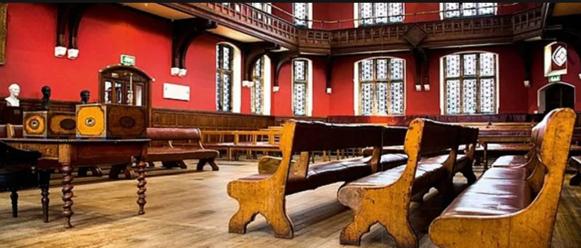
Women’s Campaign and more. No matter who you are, you will find someone fighting for your cause. SU representatives work to create support materials, give advice, fundraise, carry out lobbying strategies and organise student demonstrations. They often coordinate with JCRs, which are the student-run governing bodies of each college’s undergraduate community, to make sure that they can reach all students.
HOW DO STUDENTS GET INVOLVED IN THE OXFORD STUDENT UNION?
The Oxford SU is governed by six elected Sabbatical officers who take a year out of their studies to focus on representing student voices. However, there are also less commitment-heavy roles available for those who want to balance involvement alongside their degree work. Students can join or even run to chair the SU’s various campaigns and projects, or become a student representative on behalf of their college’s JCR.
WHY IS A STUDENT UNION A GOOD THING?
All universities, not just Oxford, have a Student Union. If we’re talking about crime and punishment, then you could see a Student Union as an
Freetime in Oxford
organisation that exists to ensure that students have justice during their time at university. This may not be so dramatic as punishment for crime, but rather the idea that all students, no matter their backgrounds or identities,


St John’s students, Rachel Pindar, Chemistry graduate, and Ambrose Hlustik-Smith, 3rd Year Biology student, have created a video showing you what they do in their free time around Oxford.
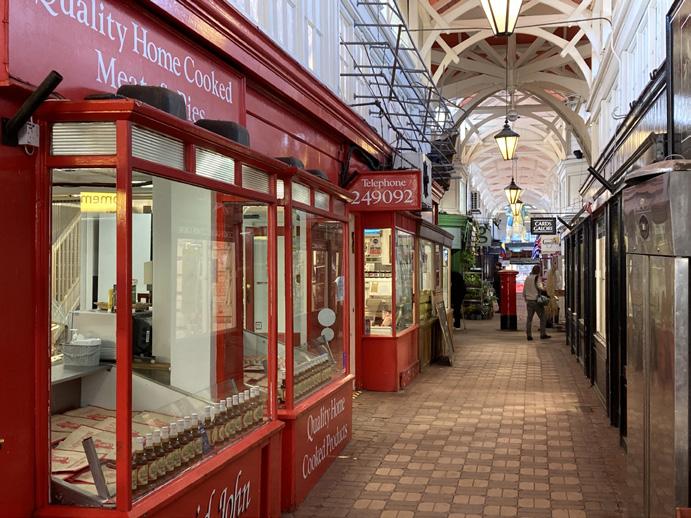
should be treated fairly. Like a lawyer represents you in court, the Student Union exists to act as your voice within the university.
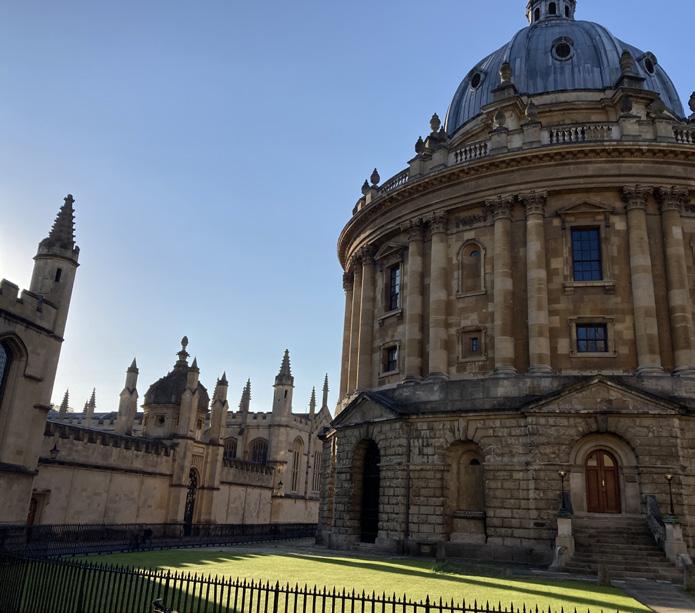

44 45
S P OTLIGHT O N OXFORD
LINK >
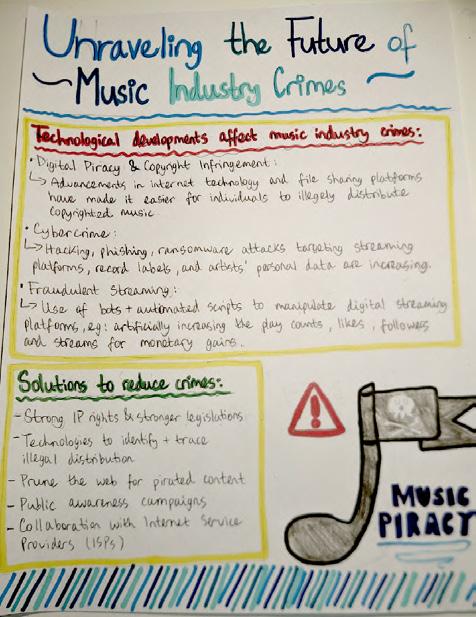
Workshop 2 Super Challenge winners
HERE IS A SELECTION OF WORK FROM OUR CRITICAL THINKERS.
We loved reading your super challenge submissions from Workshop 2 and were impressed by the quality of the entries. It was tough choosing the winners for each super challenge and we want to congratulate all who entered. Here is a sneak preview of some of the winning entries…



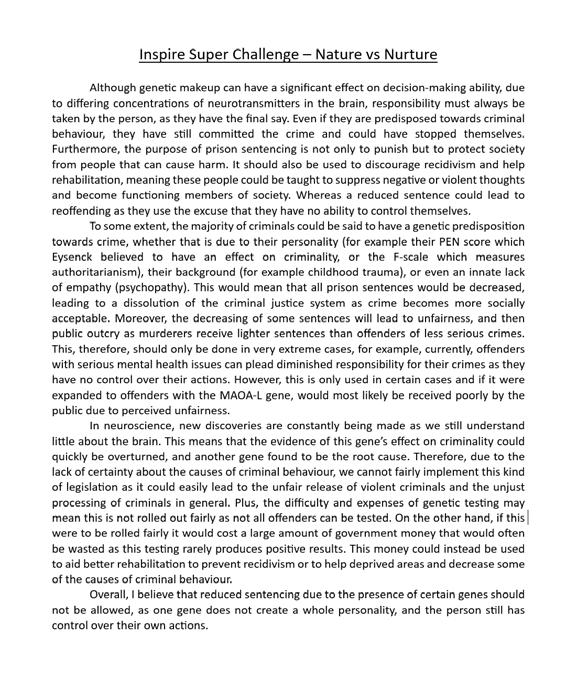
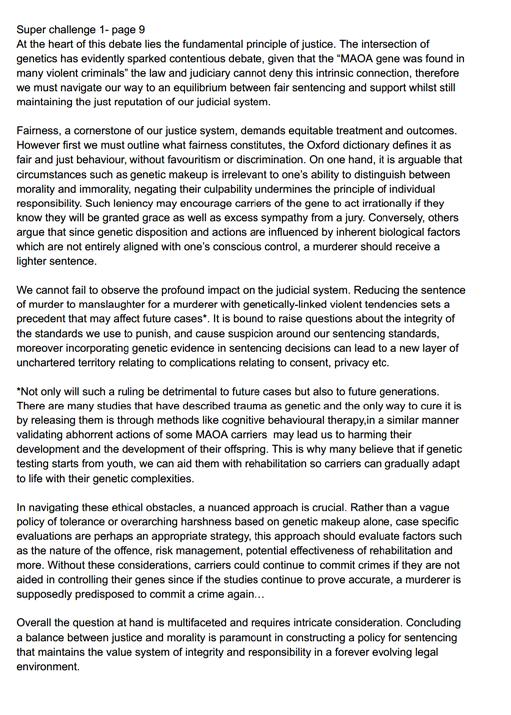
Lucy Year 11
Sackville School


Guneet
Year 9
Featherstone High School

46 47
Europa School UK Year 12 Alejna Whitmore High school Year 9 Alejna Whitmore High school Year 9 Ellie Year 9 TwyfordCEHighSchool. Ellie Year 9
CE High School Sofiia UrsulineHighSchool Year 10 Sofiia Ursuline High School Year 10
Community College HighSchool
Caitlin
Twyford
Samuel Year 11 Felpham
Lu Year 11 Sackville
School
Year 11 Avanti HouseSecondary School Zaynab Year 11 Avanti House Secondary School Nathan Year 9 Pinner HighSchool
Nathan Year 9 Pinner High School
How and why has punishment changed?
How have punishments been represented in art?
How will Ima Lyer persuade her followers to vote for her?
What strange punishments have been used throughout history?
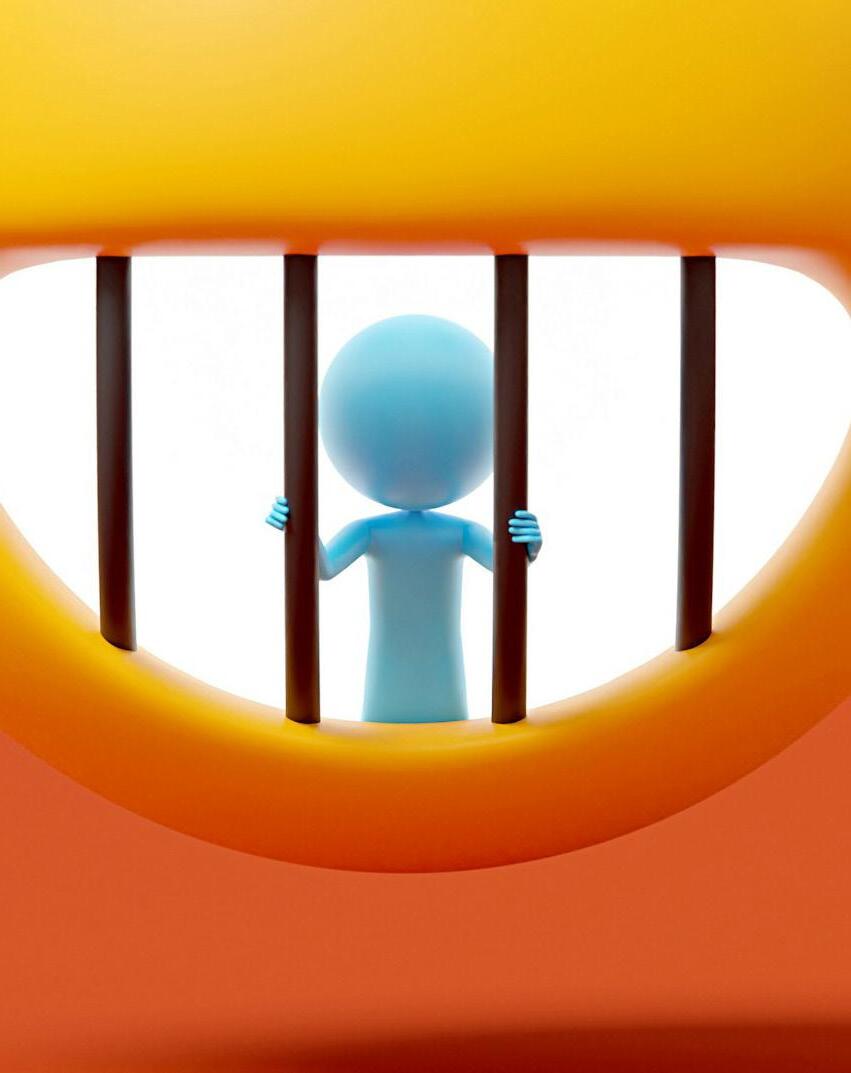
St John’s College Virtual Summer School
12th - 16th August 2024

Open to anyone on Inspire Critical Thinking! You will receive an email invitation in the summer.
What’s included?
• A range of academic talks
• Featured career talks
• An essay competition with prizes
• Study and revision guidance
• Information on our other outreach programmes
NEXT MONTH
How and why has punishment changed?
How have punishments been represented in art?
How will Ima Lyer persuade her followers to vote for her?

What strange punishments have been used throughout history?

49
Inspire Critical Thinking 2023/24
Inspire Critical Thinking 2023/24
























































































